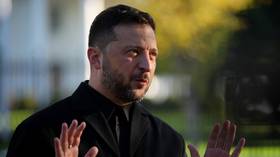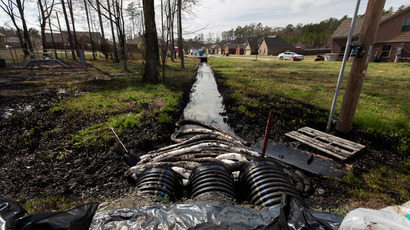FAA puts no-fly zone over Arkansas oil spill with Exxon employee in charge
The FAA announced a temporary no-fly zone would be enacted indefinitely over the Arkansas oil spill. With word that an Exxon employee was controlling the airspace, though, speculation pointed to the idea the oil company was trying to keep the media away.
The Federal Aviation Administration announced Monday that until further notice, no aircraft will be allowed to operate over the Mayflower oil spill in Conway, Arkansas. While there was scant explanation for the mandate, it was “effective immediately” - and ordered to stay in place “until further notice.”
Follow RT's in-depth day-by-day timeline on the Arkansas oil spill
The FAA's online posting raised some questions Wednesday, though, by noting that “
only relief aircraft operations under direction of Tom Suhrhoff ” are permitted in the area. On his LinkedIn profile, Suhrhoff lists himself not as an emergency expert or safety official, but as an aviation adviser for ExxonMobil. Prior to ExxonMobil, according to his profile on the professional social network, he worked as a US Army pilot for 24 years.

The only reasoning provided on FAA.gov for “temporary flight restrictions” was a “hazard” warning.
On April 1, the day flight activity was suspended, an aerial video surfaced online revealing the extent of the damage.
An FAA spokesman told reporters that the flying ban applied to aircraft flying at 1,000 feet or lower and within five nautical miles, so that emergency support are able to respond to the disaster immediately.
However, there’s been rampant speculation that the ban was enacted to censor news cameras from taking shots of the disaster area. Exxon has denied these claims, stating that there is ample aerial footage of the disaster zone. The company also maintains "temporary restrictions are a normal response to ensure flight safety."
@robertroeder There’s lots of aerial footage on YouTube. Flights only restricted for safety if below 1,000 feet.
— ExxonMobil (@exxonmobil) April 4, 2013

Lynn Lunsford, a spokesperson for the FAA, revealed that the restriction was requested by local disaster officials and that the order would eventually be amended to include news helicopters.
“They are using at least one helicopter to provide aerial support for the cleanup,” Lunsford said. “For safety reasons, they asked us to protect the airspace 1,000 feet above the area to allow the aircraft to move as needed.”
Double standard
Exxon media relations manager Alan Jeffers told RT via email that
teams are working directly with residents of Mayflower and are
“paying all valid claims relating to the spill and providing
interim housing for people from the homes which the city of
Mayflower recommended be evacuated following Friday's
spill.”
However, resident Chris Harrell tweeted after meeting with
ExxonMobil that claims would only be dealt with individually and
following the completion of the cleanup.
He added that ExxonMobil had given no assurances as to when the
cleanup would be finished.
Just spoke with @exxonmobil claims dept. "Compensation for property values and inconvenience will be addressed after clean up is complete."
— chris harrell (@shiftymcfive01) April 3, 2013
Arkansas Attorney General Dustin McDaniel, who spoke of future
litigation as a “certainty,” derided attempts by
ExxonMobil representatives to manage his visit to the site.
Speaking of potential reductions of property value in wake of the
spill, McDaniel said that monetary loses resulting from those
attempting to sell their houses “should not fall on the
shoulders of homeowners.”
He added that he had issued a subpoena for documents, data and
other evidence from ExxonMobil pertaining to the ruptured
pipeline.
Lawyers from ExxonMobil were set to arrive Wednesday in
Mayflower, Arkansas, where more than 10,000 gallons of oil
spilled from a pipeline in the town over the weekend.













